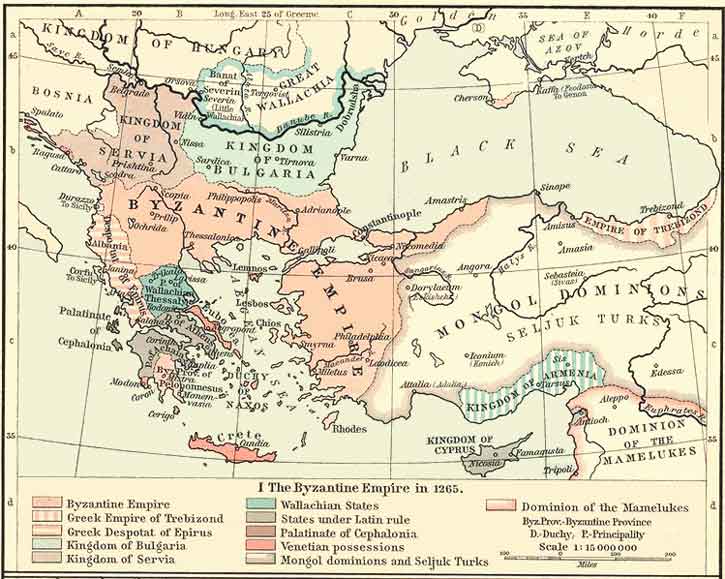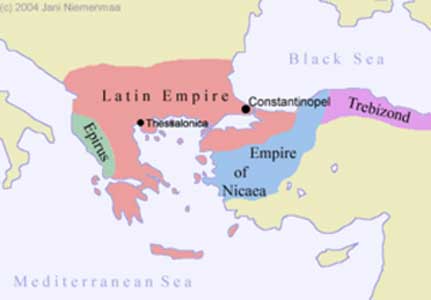.

The Empire of Trebizond and other states carved from the Byzantine Empire, as they were in 1265 (William R. Shepherd, Historical Atlas, 1911)
The Empire of Trebizond was a successor state of the Byzantine Empire founded in 1204 immediately before the fall of Constantinople. Queen Tamar of Georgia provided troops to Alexius I for the conquest of Trabzon, Sinope and Paphlagonia.
Foundation
When Constantinople fell to the Fourth Crusade in 1204, the Empire of Trebizond was one of the three smaller Greek states that emerged from the wreckage, along with the Empire of Nicaea and the Despotate of Epirus. Alexius, a grandson of Byzantine emperor Andronicus I Comnenus and a descendant of King David the Builder of Georgia through his great grandmother Katay (daughter of David the Builder), made Trebizond his capital and asserted a claim to be the legitimate successor of the Byzantine Empire.
The Emperor Andronicus was deposed and killed in 1185. His son Manuel Comnenus was blinded and died of his injuries. The sources agree that Rusudan, the wife of Manuel and the mother of Alexius and David, fled Constantinople with her children, to escape persecution by Isaac II Angelus, Andronicus' successor. It is unclear whether Rusudan fled to Georgia or to the southern coast of the Black Sea where the Comnenus family had its origins. There is some evidence that the Comnenian heirs had set up a semi-independent state centred on Trebizond before 1204.
The rulers of Trebizond used the titles Grand Comnenus, (Megas Komnenos) and Emperor until its end in 1461. The state is sometimes called the Comnenian empire because the ruling dynasty descended from Alexius I Comnenus.
Trebizond initially controlled a contiguous area on the southern Black Sea coast between Soterioupolis and Sinope, comprising the modern Turkish provinces of Sinop, Ordu, Giresun, Trabzon, Bayburt, Gumushane, Rise and Artvin. In the thirteenth century, the empire controlled Perateia which included Cherson and Kerch on the Crimean peninsula. David Comnenus expanded rapidly to the west, occupying first Sinope, then Paphlagonia and Heraclea Pontica until his territory bordered the Empire of Nicaea founded by Theodore I Lascaris. The territories west of Sinope were lost to the Empire of Nicaea by 1206. Sinope itself fell to the Seljuks in 1214.
Prosperity

While the Despotate of Epirus came to an end sixty years after its birth, and the Nicaean Empire managed to retake Constantinople and extinguish the feeble Latin Empire, only to be conquered in 1453 by the Ottoman Empire, Trebizond managed to outlive is competitors in Epirus and Nicaea.
Trebizond was in continual conflict with the Sultanate of Iconium and later with the Ottoman Turks, as well as Byzantium, the Italian republics, and especially the Genoese. It was an empire more in title than in action, surviving by playing its rivals against each other, and offering the daughters of its rulers for marriage with generous dowries, especially with the Turkmen rulers of interior Anatolia.
The destruction of Baghdad by Hulagu Khan in 1258 made Trebizond the western terminus of the Silk Road. The city grew to tremendous wealth on the Silk Road trade under the protection of the Mongols. Marco Polo returned to Europe by way of Trebizond in 1295. Under the rule of Alexius III (1349–90) the city was one of the world's leading trade centres and was renowned for its great wealth and artistic accomplishment.
Clmax and Civil War
Trebizond reached its greatest wealth and influence during the long reign of Alexius II. Trebizond suffered repeated imperial depositions and assassinations from the end of Alexius' reign until the first years of Alexius III. The empire never fully recovered ether its internal cohesion, commercial supremacy or territory.
Decline and Fall
Manuel III, who succeeded his father Alexius III as emperor in 1390, allied himself with Timur, and benefited from Timur's defeat of the Ottoman Turks at the Battle of Ankara in 1402. His son Alexius IV married two of his daughters to Jihan Shah, khan of the Black Sheep Turkmen, and to Ali Beg, khan of the White Sheep Turkmen; while his eldest daughter Maria became the third wife of the Byzantine Emperor John VIII Palaeologus. Pero Tafur, who visited the city in 1437, reported that Trebizond had less than 4000 troops.
John IV could not help but see his Empire would soon share the same fate as Constantinople. Ottoman Sultan Murad II first attempted to take the capital by sea in 1442, but high surf made the landings difficult and the attempt was repulsed. While Mehmed II was away laying siege to Belgrade in 1456, the Ottoman governor of Amisus attacked Trebizond, and although defeated, took many prisoners and extracted a heavy tribute.
John IV prepared for the eventual assault by forging alliances. He gave his daughter to the son of his brother-in-law, Uzun Hasan, khan of the White Sheep Turkmen, in return for his promise to defend Trebizond. He also secured promises of help from the Turkish emirs of Sinope and Karamania, and from the king and princes of Georgia. Unfortunately after John's death in 1458, his brother David came to power and misused these alliances. David intrigued with various European powers for help against the Ottomans, speaking of wild schemes that included the conquest of Jerusalem. Mehmed eventually heard of these intrigues, and was further provoked to action by David's demand that Murad remit the tribute imposed on his brother. Mehmed's response came in the summer of 1461: he led a sizeable army from Brusa, first to Sinope whose emir quickly surrendered, then south across Armenia and neutralizing Uzun Hasan. Having isolated Trebizond, Mehmed quickly swept down upon it before the inhabitants knew he was coming, and placed it under siege. The city held out for a month before the emperor David finalized his surrender on August 15, 1461.
List of Trapezuntine Emperors
- Alexius I Comnenus (1204–1222)
- David Comnenus (1204–1214)
- Andronicus I Gidus Comnenus (1222–1235)
- John I Axuch Comnenus (1235–1238)
- Manuel I Comnenus (1238–1263)
- Andronicus II Comnenus (1263–1266)
- George Comnenus (1266–1280)
- John II Comnenus (1280–1297)
- Alexius II Comnenus (1297–1330)
- Andronicus III Comnenus (1330–1332)
- Manuel II Comnenus (1332)
- Basil Comnenus (1332–1340)
- Irene Palaeologina (1340–1341)
- Anna Comnena (1341)
- Michael Comnenus (1341)
- Anna Comnena (restored, 1341–1342)
- John III Comnenus (1342–1344)
- Michael Comnenus (restored, 1344–1349)
- Alexius III Comnenus (1349–1390)
- Manuel III Comnenus (1390–1416)
- Alexius IV Comnenus (1416–1429)
- John IV Comnenus (1429–1459)
- David Comnenus (1459–1461)
List of Trapezuntine People
- Johannes Bessarion
- George of Trebizond
- Michael Panaretos
- George Amiroutzes
- Gregory Choniades
- John Xiphilinus
References
Michael Panaretos: Chronicle
Johannes Bessarion: The praise of Trebizond
Miller, W., Trebizond: The Last Greek Empire, (1926; repr. Chicago: Argonaut Publishers, 1968)
F.I. Uspenski, From the history of the Empire of Trabizond (Ocherki iz istorii Trapezuntskoy Imperii), Leningrad, 1929, 160 pp: a monograph in Russian.
Levan Urushadze, The Comnenus of Trabizond and the Bagrationi dynasty of Georgia. — J. "Tsiskari", Tbilisi, No 4, 1991, pp. 144–148: in Georgian.
Jonathan Phillips, The Fourth Crusade and the Sack of Constantinople, Pimlico, 2005. ISBN 1844130800
John Julius Norwich, A Short History of Byzantium ,Vintage; Reprint edition 1998, ISBN: 0679772693
| Ancient Greece
Science, Technology , Medicine , Warfare, , Biographies , Life , Cities/Places/Maps , Arts , Literature , Philosophy ,Olympics, Mythology , History , Images Medieval Greece / Byzantine Empire Science, Technology, Arts, , Warfare , Literature, Biographies, Icons, History Modern Greece Cities, Islands, Regions, Fauna/Flora ,Biographies , History , Warfare, Science/Technology, Literature, Music , Arts , Film/Actors , Sport , Fashion --- |
Retrieved from "http://en.wikipedia.org"
All text is available under the terms of the GNU Free Documentation License

